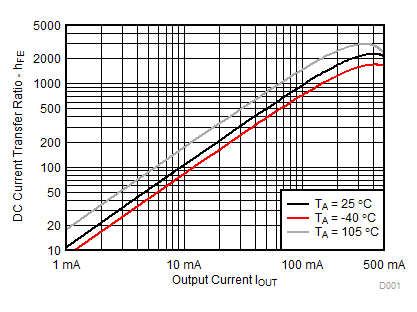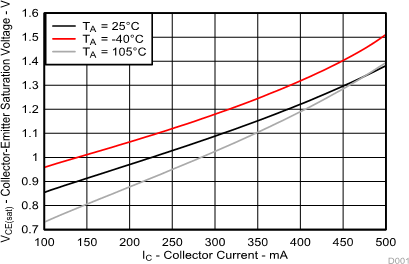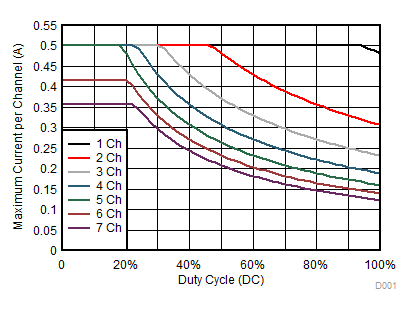SLRS064B June 2014 – August 2016 ULN2003B
PRODUCTION DATA.
- 1 Features
- 2 Applications
- 3 Description
- 4 Revision History
- 5 Pin Configuration and Functions
-
6 Specifications
- 6.1 Absolute Maximum Ratings
- 6.2 ESD Ratings
- 6.3 Recommended Operating Conditions
- 6.4 Thermal Information
- 6.5 Electrical Characteristics, TA = 25°C
- 6.6 Electrical Characteristics, TA = -40°C to +105°C
- 6.7 Switching Characteristics, TA = 25°C
- 6.8 Switching Characteristics, TA = -40°C to +105°C
- 6.9 Typical Characteristics
- 7 Parameter Measurement Information
- 8 Detailed Description
- 9 Application and Implementation
- 10Power Supply Recommendations
- 11Layout
- 12Device and Documentation Support
- 13Mechanical, Packaging, and Orderable Information
Package Options
Mechanical Data (Package|Pins)
Thermal pad, mechanical data (Package|Pins)
Orderable Information
6 Specifications
6.1 Absolute Maximum Ratings
at 25°C free-air temperature (unless otherwise noted)(1)| MIN | MAX | UNIT | |||
|---|---|---|---|---|---|
| VCC | Collector-emitter voltage | 50 | V | ||
| Clamp diode reverse voltage(2) | 50 | V | |||
| VI | Input voltage(2) | 30 | V | ||
| Peak collector current(3)(4) | 500 | mA | |||
| IOK | Output clamp current | 500 | mA | ||
| Total emitter-terminal current | –2.5 | A | |||
| TJ | Operating virtual junction temperature | 150 | °C | ||
| Tstg | Storage temperature | –65 | 150 | °C | |
(1) Stresses beyond those listed under Absolute Maximum Ratings may cause permanent damage to the device. These are stress ratings only, which do not imply functional operation of the device at these or any other conditions beyond those indicated under Recommended Operating Conditions. Exposure to absolute-maximum-rated conditions for extended periods may affect device reliability.
(2) All voltage values are with respect to the emitter/substrate terminal E, unless otherwise noted.
(3) Maximum power dissipation is a function of TJ(max), θJA, and TA. The maximum allowable power dissipation at any allowable ambient temperature is PD = (TJ(max) – TA)/θJA. Operating at the absolute maximum TJ of 150°C can affect reliability.
(4) The package thermal impedance is calculated in accordance with JESD 51-7.
6.2 ESD Ratings
| VALUE | UNIT | |||
|---|---|---|---|---|
| V(ESD) | Electrostatic discharge | Human body model (HBM), per ANSI/ESDA/JEDEC JS-001(1) | 2000 | V |
| Charged device model (CDM), per JEDEC specification JESD22-C101(2) | 500 | |||
(1) JEDEC document JEP155 states that 500-V HBM allows safe manufacturing with a standard ESD control process.
(2) JEDEC document JEP157 states that 250-V CDM allows safe manufacturing with a standard ESD control process.
6.3 Recommended Operating Conditions
over operating free-air temperature range (unless otherwise noted)| MIN | MAX | UNIT | ||
|---|---|---|---|---|
| VCC | Supply Voltage | 0 | 50 | V |
| TA | Operating free-air temperature | –40 | 105 | °C |
| TJ | Junction Temperature | –40 | 125 | °C |
6.4 Thermal Information
| THERMAL METRIC(1) | ULN2003B | UNIT | |||
|---|---|---|---|---|---|
| PW (TSSOP) | D (SOIC) | N (PDIP) | |||
| 16 PINS | 16 PINS | 16 PINS | |||
| RθJA | Junction-to-ambient thermal resistance | 105.5 | 81.2 | 49.6 | °C/W |
| RθJC(top) | Junction-to-case (top) thermal resistance | 38.3 | 40 | 36.2 | °C/W |
| RθJB | Junction-to-board thermal resistance | 50.9 | 38.6 | 29.2 | °C/W |
| ψJT | Junction-to-top characterization parameter | 4.1 | 10.5 | 20.2 | °C/W |
| ψJB | Junction-to-board characterization parameter | 50.3 | 38.3 | 29.5 | °C/W |
(1) For more information about traditional and new thermal metrics, see the Semiconductor and IC Package Thermal Metrics application report.
6.5 Electrical Characteristics, TA = 25°C
| PARAMETER | TEST FIGURE | TEST CONDITIONS | MIN | TYP | MAX | UNIT | ||
|---|---|---|---|---|---|---|---|---|
| VI(on) | On-state input voltage | Figure 19 | VCE = 2 V | IC = 200 mA | 2.4 | V | ||
| IC = 250 mA | 2.7 | |||||||
| IC = 300 mA | 3 | |||||||
| VCE(sat) | Collector-emitter saturation voltage | Figure 18 | II = 250 μA, | IC = 100 mA | 0.9 | 1.1 | V | |
| II = 350 μA, | IC = 200 mA | 1 | 1.3 | |||||
| II = 500 μA, | IC = 350 mA | 1.2 | 1.6 | |||||
| ICEX | Collector cutoff current | Figure 15 | VCE = 50 V, | II = 0 | 10 | μA | ||
| VF | Clamp forward voltage | Figure 21 | IF = 350 mA | 1.7 | 2 | V | ||
| II(off) | Off-state input current | Figure 16 | VCE = 50 V, | IC = 500 μA | 50 | 65 | μA | |
| II | Input current | Figure 17 | VI = 3.85 V | 0.93 | 1.35 | mA | ||
| IR | Clamp reverse current | Figure 20 | VR = 50 V | 50 | μA | |||
| Ci | Input capacitance | VI = 0, | f = 1 MHz | 15 | 25 | pF | ||
6.6 Electrical Characteristics, TA = –40°C to +105°C
| PARAMETER | TEST FIGURE | TEST CONDITIONS | MIN | TYP | MAX | UNIT | ||
|---|---|---|---|---|---|---|---|---|
| VI(on) | On-state input voltage | Figure 19 | VCE = 2 V | IC = 200 mA | 2.7 | V | ||
| IC = 250 mA | 2.9 | |||||||
| IC = 300 mA | 3 | |||||||
| VCE(sat) | Collector-emitter saturation voltage | Figure 18 | II = 250 μA, | IC = 100 mA | 0.9 | 1.2 | V | |
| II = 350 μA, | IC = 200 mA | 1 | 1.4 | |||||
| II = 500 μA, | IC = 350 mA | 1.2 | 1.7 | |||||
| ICEX | Collector cutoff current | Figure 15 | VCE = 50 V, | II = 0 | 20 | μA | ||
| VF | Clamp forward voltage | Figure 21 | IF = 350 mA | 1.7 | 2.2 | V | ||
| II(off) | Off-state input current | Figure 16 | VCE = 50 V, | IC = 500 μA | 30 | 65 | μA | |
| II | Input current | Figure 17 | VI = 3.85 V | 0.93 | 1.35 | mA | ||
| IR | Clamp reverse current | Figure 20 | VR = 50 V | 100 | μA | |||
| Ci | Input capacitance | VI = 0, | f = 1 MHz | 15 | 25 | pF | ||
6.7 Switching Characteristics, TA = 25°C
| PARAMETER | TEST CONDITIONS | MIN | TYP | MAX | UNIT | ||
|---|---|---|---|---|---|---|---|
| tPLH | Propagation delay time, low- to high-level output | 0.25 | 1 | μs | |||
| tPHL | Propagation delay time, high- to low-level output | 0.25 | 1 | μs | |||
| VOH | High-level output voltage after switching | VS = 50 V, | IO ≈ 300 mA | VS – 20 | mV | ||
6.8 Switching Characteristics, TA = –40°C to +105°C
| PARAMETER | TEST CONDITIONS | MIN | TYP | MAX | UNIT | ||
|---|---|---|---|---|---|---|---|
| tPLH | Propagation delay time, low- to high-level output | 1 | 10 | μs | |||
| tPHL | Propagation delay time, high- to low-level output | 1 | 10 | μs | |||
| VOH | High-level output voltage after switching | VS = 50 V, | IO ≈ 300 mA | VS – 50 | mV | ||
6.9 Typical Characteristics
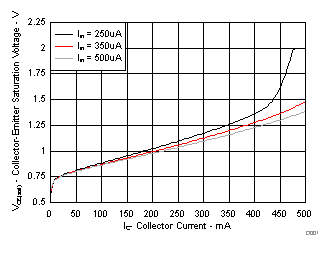
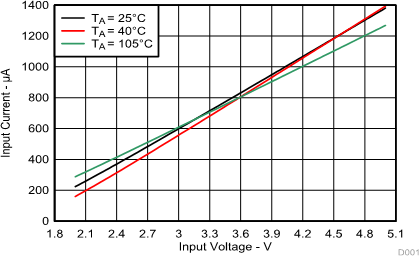
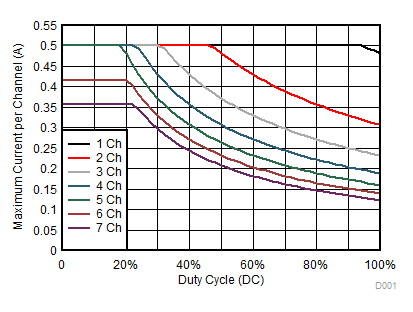
| TA = 25ºC |
vs Duty Cycle
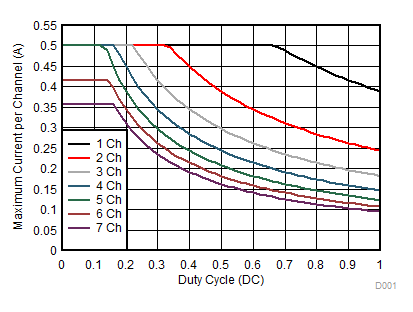
| TA = 70ºC |
vs Duty Cycle
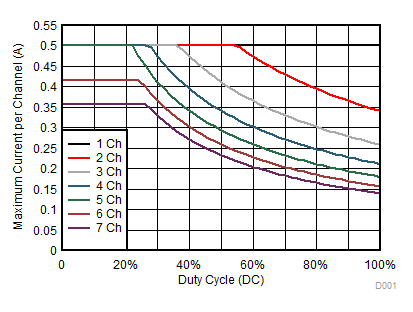
| TA = 70ºC |
vs Duty Cycle
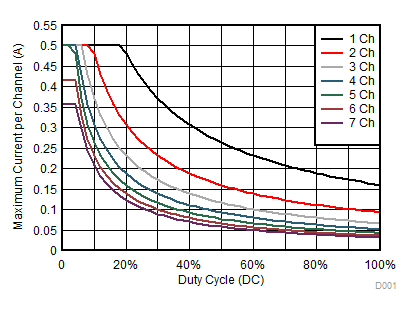
| TA = 105ºC |
vs Duty Cycle
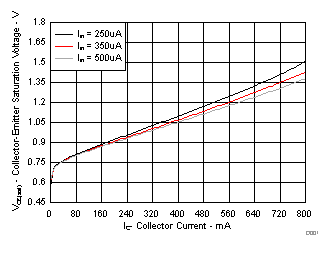
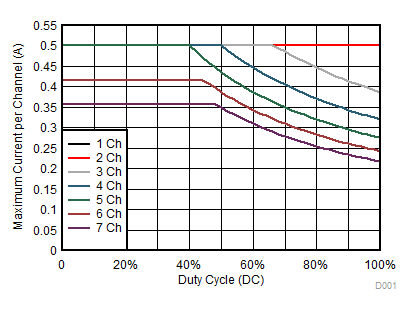
| TA = 25ºC |
vs Duty Cycle
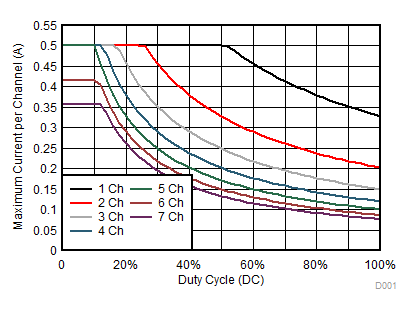
| TA = 70ºC |
vs Duty Cycle
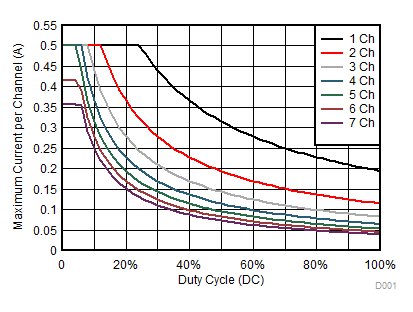
| TA = 105ºC |
vs Duty Cycle
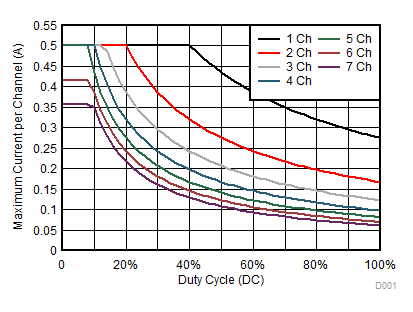
| TA = 105ºC |
